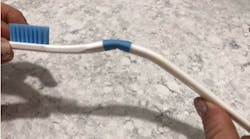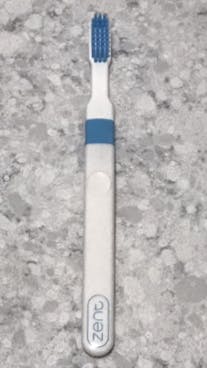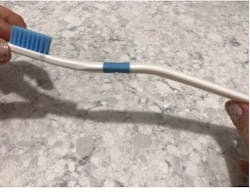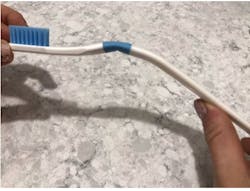We spend countless hours per year teaching our patients to properly brush their teeth. Today's electric toothbrushes even try to help us with this: they have built-in timers and pressure sensors, and some use artificial intelligence to encourage a complete toothbrushing experience. It's all part of a united effort to keep our patients on track. But electric toothbrushes have a smaller market share among Americans today. According to Statista, in 2019 nearly 266 million Americans used a manual toothbrush1 and approximately 123 million used an electric toothbrush.2 If so many people are still using manual toothbrushes, how can we ensure that they are utilizing proper toothbrushing technique? And is there a product that can help reinforce good technique?
Manual toothbrushes: Today's challenges
A person with adequate dexterity and brushing technique can remove plaque as effectively with a manual toothbrush3 as an electric toothbrush, but brushing with a manual toothbrush seems to yield inferior results.4 Why is this? For one thing, people brush their teeth for only 47 seconds on average, which is far below the recommended two minutes.5
If we as clinicians can't get through to patients about how long they should brush their teeth, then how can we expect them to learn how to do things such as use proper brushing pressure—a key part of successful manual toothbrushing?
Proper brushing pressure has been a known challenge for some time. Aggressive toothbrushing can lead to gingival abrasion, recession, and loss of tooth structure.6 In fact, pressure that is greater than 150 g can be damaging to gingival tissues7 and has been linked to greater dentinal hypersensitivity.8 But does anyone know how much pressure 150 g equates to clinically? (I certainly didn't.)
I have always considered myself a "professional toothbrusher." After all, I have an associate degree in dental hygiene, a bachelor's degree in dental hygiene, and a dental degree, plus I am a board-certified prosthodontist. Surely I should be able to safely brush my teeth for the correct amount of time and with the proper amount of pressure...
Boy, was I wrong.
Just how wrong was I? I didn't know until I came across the ZentFlex toothbrush, which addresses the pressure issue head-on. ZentFlex is a manual toothbrush that bends and makes a "clicking" sound when greater than 150 g of pressure is applied (figures 2 and 3).
Here’s my experience with ZentFlex, as recorded in my "toothbrush diary."
Day one: Four clicks
Dear diary: I am extremely surprised to discover how little pressure caused this brush to bend. I applied an appropriate pressure on most of my tooth surfaces, but quickly realized that I tend to "scrub" localized areas in my mouth. It required multiple attempts to correct my technique.
Day two: Two clicks
Dear diary: I was trying to be mindful of the pressure I was applying to my teeth while brushing, but it’s tough to break old habits. I seem to have figured out the proper approach to apply a safe amount of pressure to the questionable areas from the day before, but I still have some work to do.
Day three: Zero clicks
Dear diary: Success! I have been able to figure out how to brush my teeth with a manual toothbrush without applying unnecessary—or potentially damaging—pressure to my tooth surfaces. I have found that brushing with less than 150 g of pressure to my tooth surfaces has instinctually increased my brushing time. I am finally practicing what I preach with manual toothbrushing: more time, less pressure.
Day four and after
Dear diary: I have found that brushing with ZentFlex has encouraged mindful toothbrushing with proper techniques. I shared this toothbrush with some of my colleagues and my patients and the consensus seems to be the same: “I cannot believe how much pressure I was applying to my teeth!” To be completely honest, my brush still clicks from time to time, reminding me that my aggressive brushing habit has not completely resolved.
Lessons learned
I have spent numerous years discussing the facts about RDA (relative dentin abrasion) values and toothpaste abrasivity. Despite conflicting evidence,9 many commercially available toothpastes have been criticized for playing a role in tooth abrasion, gingival recession, and even noncarious cervical lesions.10
My next statement is pure conjecture: If, in general, we are applying too much pressure to our tooth structure and marginal gingiva with our manual toothbrushes, I’m wondering if we might owe some of our toothpaste-manufacturing colleagues an apology. I would argue that it's a question worth pondering.
I encourage all of you to give the ZentFlex pressure-sensitive toothbrush a try. For me, it was an incredibly eye-opening experience to comprehend that when using a manual toothbrush, I have been brushing my teeth with too much pressure. This simple, clever technology can encourage safer brushing habits for manual toothbrushers. I would be interested to hear how many clicks you get!
Editor's note: This article first appeared in The Product Navigator, a twice-monthly newsletter from DentistryIQ, Dental Economics, and RDH. To subscribe, visit the DentistryIQ subscription page.
References
Also by Dr. Maragliano-Muniz
Coronavirus impact on dental practices: All things HR [Video]
Coronavirus impact on dental practices: Taxes, new laws, and cash flow [Video]
Editor's Note: Highlights from the Chicago Dental Society's Midwinter Meeting










